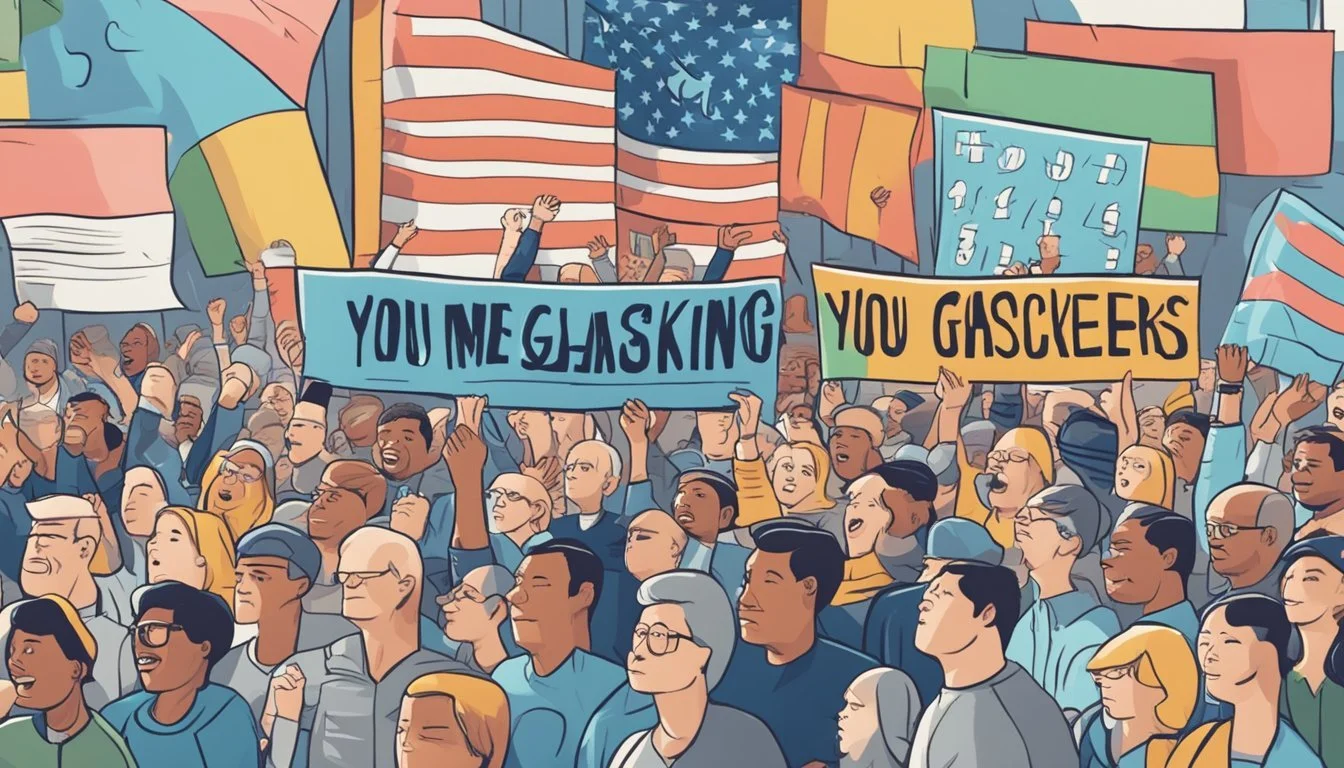Fact-Checkers Under Scrutiny: Exposing Potential Biases in Information Control
Fact-checkers, once heralded as guardians of truth in the digital age, have come under scrutiny for potentially misleading the public. Some argue these trusted sources may engage in gaslighting - a form of psychological manipulation that causes people to question their own perceptions and memories.
Fact-checkers can sometimes present incomplete or biased information that distorts reality rather than clarifying it. This paradoxical situation leaves many feeling confused and uncertain about whom to trust for accurate information. The very institutions meant to combat misinformation may inadvertently contribute to its spread.
Examining the methods and motivations of fact-checkers is crucial for media literacy. By understanding potential biases and limitations in fact-checking processes, readers can better navigate the complex landscape of modern information and develop their own critical thinking skills. This awareness empowers individuals to make more informed judgments about the credibility of various sources and claims.
Understanding Fact-Checking and Gaslighting
Fact-checking and gaslighting represent two opposing approaches to information and truth. While fact-checkers aim to verify claims, gaslighting manipulates perception and sows doubt.
The Role of Fact-Checkers
Fact-checkers evaluate the accuracy of statements and claims made by public figures, media outlets, and online sources. Organizations like USA Today, Associated Press, and PolitiFact investigate assertions and rate their truthfulness.
These entities examine primary sources, consult experts, and analyze data to reach conclusions. They typically use rating scales to categorize claims from "True" to "False" or "Pants on Fire."
Fact-checkers strive for objectivity and transparency. Many publish detailed methodologies and sources in their privacy policies. Their goal is to provide readers with verified information to make informed decisions.
Gaslighting Techniques and Indicators
Gaslighting is a form of psychological manipulation that causes someone to question their own perception of reality. It can occur in personal relationships, politics, and media.
Common gaslighting tactics include:
• Denying events occurred • Trivializing emotions • Shifting blame • Withholding information • Using confusion tactics
Signs of gaslighting may include feeling confused, doubting one's memory, and questioning one's judgment. The gaslighter often positions themselves as the authority on truth.
In media, gaslighting can involve presenting demonstrably false information as fact or dismissing credible sources. This erodes trust in institutions and muddles public discourse.
Legislation and Privacy Concerns
Recent legislation has raised concerns about privacy and individual rights related to motor vehicle operation. New technologies enabling remote vehicle control have sparked debates about government overreach and constitutional protections.
Bipartisan Infrastructure Legislation 2026
The 2026 bipartisan infrastructure bill includes a provision for a "vehicle kill switch" mandate. This technology would allow authorized parties to remotely disable cars. Proponents argue it could improve safety and reduce theft. Critics worry about potential abuse and invasion of privacy.
The mandate requires all new vehicles sold after 2026 to have this capability built-in. Automakers must comply or face penalties. Some lawmakers have opposed the measure, citing concerns about government overreach.
Privacy Rights and New Technologies
Advanced vehicle technologies pose challenges for privacy protection. GPS tracking, data collection, and remote access capabilities raise questions about information security and personal autonomy.
Consumer advocacy groups argue for stricter regulations on data collection and use by automakers and third parties. They emphasize the need for transparency and user consent. Some states have begun implementing laws to address these concerns.
The Fourth Amendment and Motor Vehicle Operation
The vehicle kill switch mandate has sparked Fourth Amendment debates. Legal experts question whether remote disabling of cars constitutes an unreasonable search or seizure.
Courts have historically granted less privacy protection to motor vehicles than homes. However, the extent of this distinction remains unclear for new technologies. Some argue that remote access to vehicle systems crosses a constitutional line.
Legal challenges to the mandate are expected. The outcome could significantly impact future interpretations of privacy rights in the digital age.
Public Reaction and Political Perspectives
The debate over vehicle surveillance mandates has sparked diverse reactions across the political spectrum. Politicians and citizens have expressed concerns about privacy, government overreach, and the balance between safety and civil liberties.
Libertarian Viewpoints on Privacy and Control
Libertarian-leaning politicians have strongly opposed vehicle surveillance measures. Thomas Massie, a Republican representative known for his libertarian views, has vocally criticized proposals for mandatory vehicle tracking systems. He argues such mandates infringe on personal freedoms and enable excessive government control.
Bob Barr, former US Representative from Georgia and Libertarian Party presidential nominee, echoed these sentiments in a political column. Barr emphasized the importance of the Fourth Amendment in protecting citizens from unreasonable searches and seizures. He warned that normalizing constant vehicle monitoring could lead to further erosion of privacy rights.
Democrats and Republicans on Vehicle Mandates
The issue has created unusual alliances across party lines. Some Republicans have joined libertarians in opposing mandates, citing concerns about government overreach. They argue for market-driven solutions rather than federal requirements.
Many Democrats support the measures, framing them as critical for public safety and emissions reduction. They point to potential benefits like improved emergency response times and reduced traffic fatalities. However, privacy-minded Democrats have also raised concerns.
A proposed amendment to limit vehicle surveillance failed to pass, highlighting the complex political dynamics. The vote did not follow strict party lines, with both Republicans and Democrats crossing traditional boundaries based on individual stances on privacy and regulation.
Detailed look at the 2026 Vehicle Kill Switch Mandate
The 2026 Vehicle Kill Switch Mandate has sparked debate about safety measures and privacy concerns in new vehicles. The technology aims to reduce impaired driving fatalities but raises questions about potential misuse.
Kill Switch Technology and Implications for Motorists
The mandate requires new vehicles to include advanced drunk and impaired driving prevention technology. This AI-driven system will monitor driver performance through various sensors. If impairment is detected, the technology can prevent or limit motor vehicle operation.
The system may analyze factors like:
Erratic steering
Sudden braking or acceleration
Lane departure
Eye movement
Proponents argue this could significantly reduce accidents caused by impaired driving. Critics worry about false positives and system malfunctions that could strand motorists.
The exact implementation details are still being developed by automakers and regulators. Privacy advocates have raised concerns about data collection and storage related to driver monitoring.
Potential for Government Overreach and Abuse
Some fear the kill switch technology could be exploited for surveillance or control. There are concerns that law enforcement or other government agencies might gain remote access to vehicle systems.
However, fact-checkers have disputed claims of a universal "kill switch" accessible to authorities. The legislation does not explicitly grant such powers.
Safeguards will be crucial to prevent misuse. These may include:
Strict data protection rules
Limits on who can access vehicle systems
Transparency about how the technology works
Balancing safety benefits with privacy protections remains a key challenge as the mandate's implementation approaches.
Surveillance, Technology, and the Individual
Modern surveillance technologies raise complex questions about privacy rights and government overreach. Traffic monitoring systems and intelligence gathering practices have expanded rapidly, creating tension with traditional notions of individual liberty.
Traffic Monitoring and Individual Privacy
Traffic cameras and license plate readers are now ubiquitous on roads and highways across the United States. These systems capture and store data on millions of vehicle movements daily. Law enforcement agencies argue this information is crucial for public safety and crime prevention. Critics contend it enables unprecedented mass surveillance of citizens' daily activities.
The National Highway Traffic Safety Administration (NHTSA) has proposed rules requiring new vehicles to have alcohol detection systems. These could prevent operation if a driver is impaired. While intended to reduce drunk driving, some see it as government overreach into personal vehicle use.
The Balance Between Safety and Privacy
Intelligence agencies like the NSA conduct extensive digital surveillance, often without warrants. They claim this is necessary to prevent terrorism and protect national security. Privacy advocates argue it violates Fourth Amendment protections against unreasonable searches.
"Fusion centers" aggregate data from multiple government and private sources. This raises concerns about the vast amount of information collected on individuals without their knowledge or consent.
The Framers of the Constitution sought to protect individual liberty from government intrusion. Modern technology has created new challenges in maintaining this balance. Policymakers face difficult trade-offs between security needs and preserving the privacy rights central to a free society.
Personal Data Security in the Digital Age
Digital technologies have revolutionized how we share and store information, but they've also created new risks for personal data. Protecting one's digital identity and understanding app permissions are crucial steps in safeguarding privacy online.
Protecting Your Digital Identity
Strong passwords and two-factor authentication are essential for securing online accounts. When creating usernames and passwords, avoid using easily guessable information. Instead, use a mix of letters, numbers, and symbols.
Many platforms offer two-factor authentication, which adds an extra layer of security. This often involves entering a code sent to your phone number or generated by an authenticator app. It's wise to keep backup codes in a safe place in case you lose access to your primary authentication method.
Regularly updating passwords and avoiding password reuse across multiple accounts can significantly reduce the risk of unauthorized access. Be cautious when clicking links in emails or messages, as phishing attempts often target login credentials.
Understanding App Permissions and Data Collection
Before installing apps, review their privacy policies and user agreements. These documents outline how the app collects, uses, and shares your data. Pay close attention to permissions requested during installation.
Many apps ask for access to your phone's camera, microphone, or location. Grant these permissions only if necessary for the app's core functions. Regularly review and update app permissions in your device settings.
Be wary of apps that request excessive data access. Free apps often collect more user data as part of their business model. Consider using paid alternatives if privacy is a priority.
When scanning QR codes, be cautious of where they lead. Malicious QR codes can direct users to harmful websites or prompt unwanted downloads. Use a trusted QR scanner app that previews URLs before opening them.






